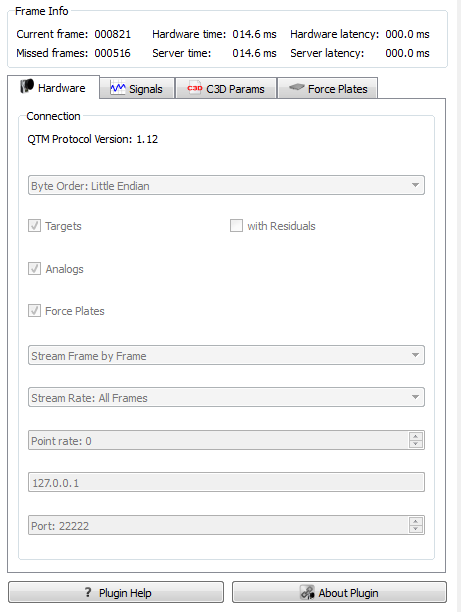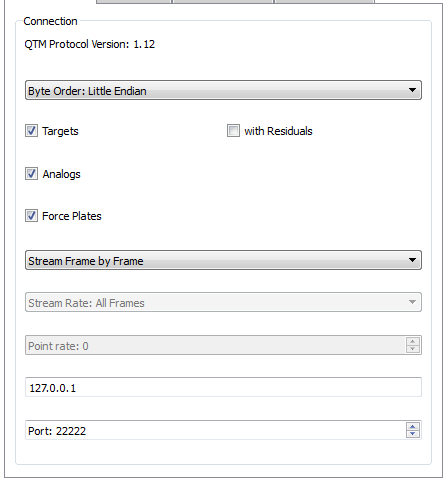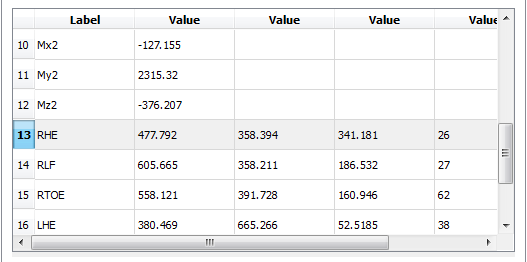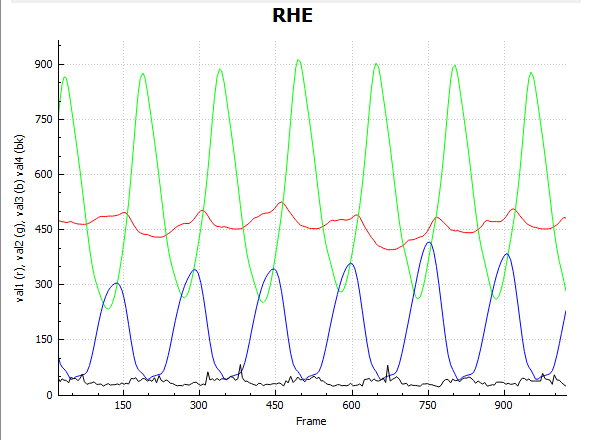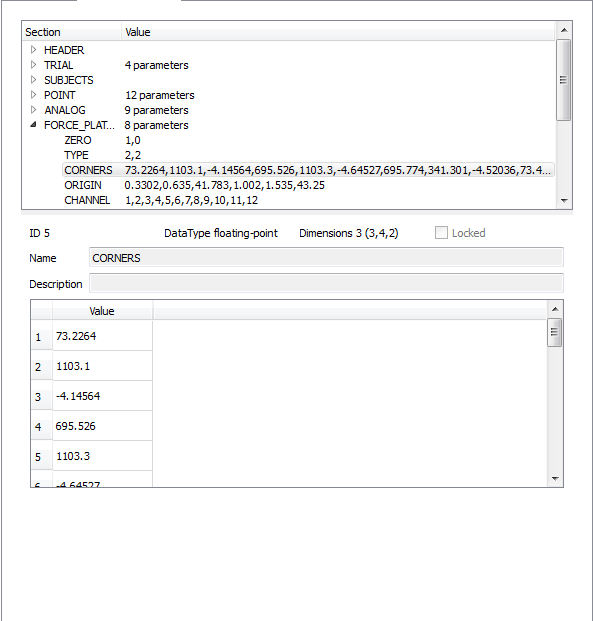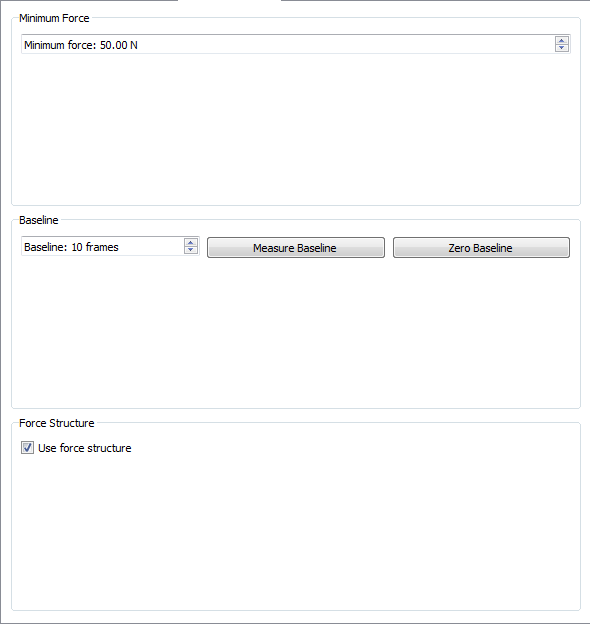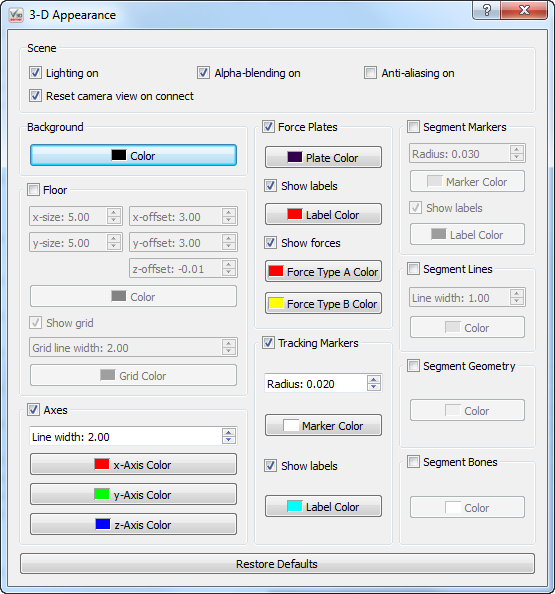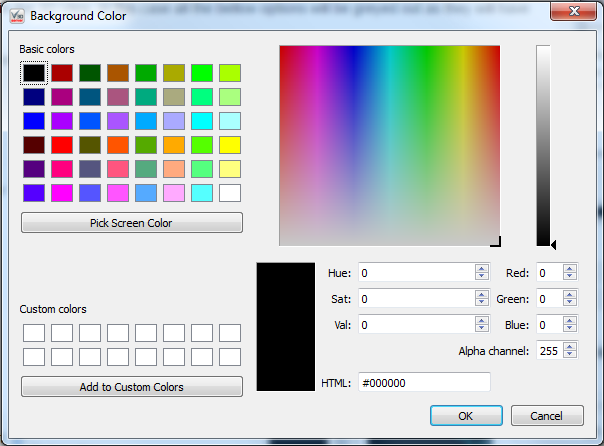Table of Contents
RT Plugin Qualisys QTM
Overview
The Qualisys QTM;&trade Plugin is used in Visual3D Server™, and Visual3D RT™, it connects to Qualisys™ software.
Plugin Interface
The “Plugin Help” button leads to this web page should you need to reference this page in the future.
The “About Plugin” button has details on the plugin being used including version, release date, copy right, support contact information and the hardware SDK version.
Frame Info
Current frame The current frame number on the top left hand side on the screen (where it currently reads 000821) keeps a count of the current frame which is assigned by the hardware or software system.
Missed frames The missed frames number is on the bottom left (where it currently reads 000516). Whenever there is a gap in frames sent by the hardware of software system a blank frame is inserted. The dropped frames count keeps a record of both the number of frames which are blank.
Hardware time The hardware time number is on the top, in the centre (where it currently reads 014.6). This time stamp is created by the hardware being used and is how long, in milliseconds, the hardware has been running.
Server time The server time number is on the bottom, in the centre (where it currently reads 014.6). This time stamp is created by the server and is how long, in milliseconds, it has been connected to the hardware or software which is streaming to it.
Hardware latency The hardware latency is on the top right hand side (where it currently reads 000.0 ms). This indicated the delay created by the hardware system.
Server latency The hardware latency is on the top right hand side (where it currently reads 000.0 ms). This indicates any delay introduced by the server.
Hardware
Network Protocol
This is the QTM Protocol Version that is being used by Visual3DServer, in the example it is version 1.12. This version increases with newer versions of the Server.
Byte Order
Byte order may either be set to Little Endian or Big Endian. Byte order sets how a computer codes and reads the Bytes which it works with. Little Endian means that the least important data is coded and read first. On the other hand Big Endian means that the most important data is coded and read first. Computer systems vary on how they organize their data so the QTM plugin allow you to specify which type of organization to use.
Data Types
There are three sets of data types which you can chose to have stream from the QTM system to Visual3DServer, target, analogue and force plate. Target data is any optical data which is being produced by the QTM cameras. The residuals data indicates the quality of the marker data that is being produced. Analogue data can be produced from any analogue data source including force data and EMG signals. Force plate data is the coordinates for the corners of the force plates in the lab volume.
If you chose to accept all three types of data at the same time it is likely that the programs will slow down and there may be a noticeable lag in the data. If your computer is not powerful enough to accept all the data at once it is recommended that you stream only the data that you need.
Stream Settings
The QTM plugin may be set to stream over TCP, UDP or Frame by Frame. TCP stands for Transmission Control Protocol which is a type of Internet Protocol. It can detect and sometimes correct for problems such as lost, duplicated or delivered out of order data. UDP stands for User Datagram Protocol which is also a type of Internet Protocol. It does not correct errors and thus allows the data to be transmitted more quickly. The final option is Frame by Frame which transmits all the data generated by the QTM system to the server. If this setting is active you will not be able to control the Stream Rate.
Stream Rate & Point Rate
Stream Rate options are available for the TCP and UDP stream options. This allows you to control how frequently the Server receives new frames of data. The Stream Rate options that are available are All Frames, Frequency and Frequency Devisor. If the stream rate is set to all frames then all of the frames recorded by the system will be passed onto the Server. As a result you need not set the point rate that text field will be greyed out. If the stream rate is set to frequency then you can request how many frames you wish to receive. The frequency of frames you wish to receive, in Hertz, is entered into the point rate text field. If the stream rate is set to frequency devisor you are requesting a sample of the frames generated by the system. The point rate that you input which fraction of the frames you would like to receive from the system. For example if the QTM system collects at 200 Hertz and the point rate is set at 2 then the Server will receive frames at 100 Hertz (200/2 = 100).
IP Address & Port Number
The IP address and Port Number allows Visual3DServer to locate the data that is being broadcast. Both of these need to be set before connecting to QTM. Once the programs are connected the IP address and Port fields will become greyed out and will remain inaccessible until you disconnect the programs. The ServerIP address must be entered into the dialogue box in the hardware tab. The IP address used in the image above is 127.0.0.1. QTM™ does allow for the “localhost” or 127.0.0.1 shortcuts to be used. If you need help finding the IP address of the computer running the data capture see Trouble Shooting. The Port Number is a port which has been chosen by QTM to broadcast data from. QTM uses port number 22222 which is the default in Visual3DServer. QTM does allow you to change the port number which it uses in the project options setting. More details about QTM port numbers can be found in the QTM RT protocol.pdf which is installed with QTM. If you have inputted the correct IP address and Port number 22222 and are receiving an error message please contact support@c-motion.com.
Signals
C3D Params
Force Platform
3D View
The right hand side of the screen provides a real-time 3D graphical representation of the data being streamed.
Save 3D View
This button allows you to save what is currently being displayed in the 3D view graphics area. The image can be saved in a number of standard formats, such as .bmp, .ico, .jpeg, .jpg, .pbm, .pgm, .png, .ppm, .tif, .tiff, .wbmp, .xbm, or .xpm. This function is ideal for producing graphics for papers or presentations. Saved images can be edited with 3rd party graphics programs if needed.
Copy 3D View to clipboard
This button allows you to copy what is currently being displayed in the 3D view graphics area to the clipboard. This allows you to paste the image into any program that supports copy and paste. This is useful for working with presentation or graphics editing software.
Reset camera 3D View
This button brings the 3D viewer back to it's beginning position. You may find that having used the rotation, translation, and zooming capabilities of the 3D view you have lost track of where you are in the graphics, which can make returning to a proper view of your data challenging. The reset view button removes this frustration and reorients you.
3D View Preferences
This button allows you to change how the graphics that are presented to you. Changes happen in real time. At the bottom is the “Restore Defaults” button which resets all of the options to their standard setting.
= Scene =
Lighting on - When selected graphics that are suppose to be 3 dimensional have shadows to help simulate shape. When not selected objects are one solid color.
Reset camera view on connect - When this box is selected and you connect or reconnect to hardware the camera view will reset to it's default.
Alpha-blending on - When this box is selected the graphics are slightly transparent and allow you to see what is behind them
Anti-ailiasing on - When this box is selected all the lines in the graphics are smooth. If it is not selected the lines that are not either horizontal or vertical change directions portion by portion.
= Background =
Color - This allows you to change the background color to anyone you chose.
= Floor =
When the check box next to the floor is not checked the floor will not appear in the 3D View. In this case all the bellow options will be greyed out as they will have no effect if the floor is not present.
X-size - This allows you to customize how many panels the floor is composed of in the x direction. the minimum is 1 and maximum is 100. The default size is 5.00.
Y-size - This allows you to customize how many panels the floor is composed of in the y direction. the minimum is 1 and maximum is 100. The default size is 5.00.
X-offset - This allows you to shift the entire floor along the x-axis either in the positive or negative direction. The maximum value allowed is 100 and the minimum value is -100. The default setting is 3.00.
Y-offset - This allows you to shift the entire floor along the y-axis either in the positive or negative direction. The maximum value allowed is 100 and the minimum value is -100. The default setting is 3.00.
Z-offset - This allows you to shift the entire floor along the z-axis either in the positive or negative direction. The maximum value allowed is 100 and the minimum value is -100. The default setting is -0.01.
Color - This allows you to change the floor color to anyone you chose.
Show grid - This allows you to remove the grid lines from the floor by unchecking the checkbox.
Grid line width - This allows you to change the thickness of the gridlines. The minimum value is 1 and the maximum value is 10. The default width is 2.00.
Grid color - This allows you to change the grid line color to anyone you chose.
= Axes =
When the check box next to the axis is not checked the axis will not appear in the 3D View. In this case all the bellow options will be greyed out as they will have no effect if the axis is not present.
Line width - This allows you to change the thickness of the axis lines. The minimum value is 1 and the maximum value is 10. The default value is 2.00.
X-Axis Color - This allows you to change the x-axis line color to anyone you chose.
Y-Axis Color - This allows you to change the y-axis line color to anyone you chose.
Z-Axis Color - This allows you to change the z-axis line color to anyone you chose.
= Force Plates =
When the check box next to the force plates is not checked the force plates will not appear in the 3D View. In this case all the bellow options will be greyed out as they will have no effect if the force plates are not present.
Plate Color - This allows you to change the force plate color to anyone you chose.
Show labels - This allows you to remove the force plate label, (such as FP1, FP2 . . . etc) from the 3D view.
Label Color - This allows you to change the force plate label color to anyone you chose.
Show forces - When checked the forces will be show in the 3D view using arrows.
Force Type A Color - This allows you to change the color of the raw force arrows to anyone you chose.
Force Type B Color - This allows you to change the color of the force structure arrows to anyone you chose.
= Tracking Markers =
When the check box next to the tracking markers is not checked the tracking markers will not appear in the 3D View. In this case all the bellow options will be greyed out as they will have no effect if the tracking markers are not present.
Radius - This allows you to change the radius of the markers. The maximum value is 0.100 the minimum value is 0.001. The default radius is 0.020.
Marker Color - This allows you to change the color of the marker color to anyone you chose.
Show Labels - This allows you to remove the marker labels from the 3D view.
Label Color - This allows you to change the color of the label to anyone you chose.
= Segment Markers =
When the check box next to the segment markers is not checked the segment markers will not appear in the 3D View. In this case all the bellow options will be greyed out as they will have no effect if the segment markers are not present.
Radius - This allows you to change the radius of the markers. The maximum value is 0.100 the minimum value is 0.001. The default radius is 0.020.
Marker Color - This allows you to change the color of the marker color to anyone you chose.
Show Labels - This allows you to remove the marker labels from the 3D view.
Label Color - This allows you to change the color of the label to anyone you chose.
= Segment Lines =
When the check box next to the segment lines is not checked the segment lines will not appear in the 3D View. In this case all the bellow options will be greyed out as they will have no effect if the segment lines are not present.
Line Width - This allows you to change the thickness of the segment lines. The minimum value is 1 and the maximum value is 10. The default value is 1.00.
Color - This allows you to change the color of the segment lines to anyone you chose.
= Segment Geometry =
When the check box next to the segment geometry is not checked the segment geometry will not appear in the 3D View. In this case all the bellow options will be greyed out as they will have no effect if the segment geometry is not present.
Color - This allows you to change the color of the segment geometry to anyone you chose.
= Segment Bones =
When the check box next to the segment bones is not checked the segment bones will not appear in the 3D View. In this case all the bellow options will be greyed out as they will have no effect if the segment bones are not present.
Color - This allows you to change the color of the segment bones to anyone you chose.

